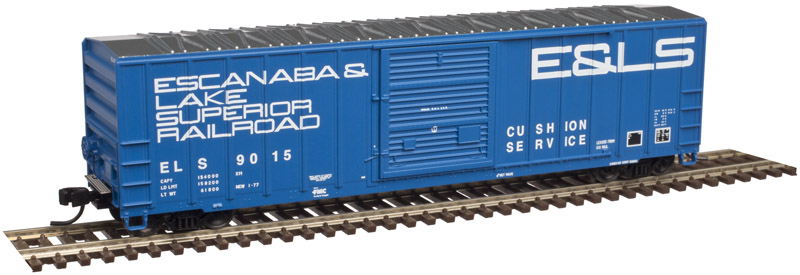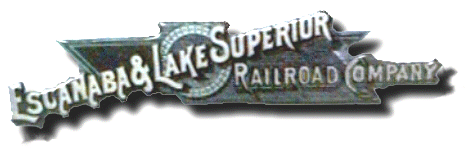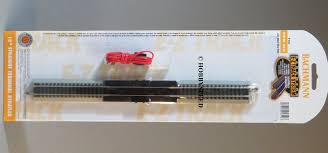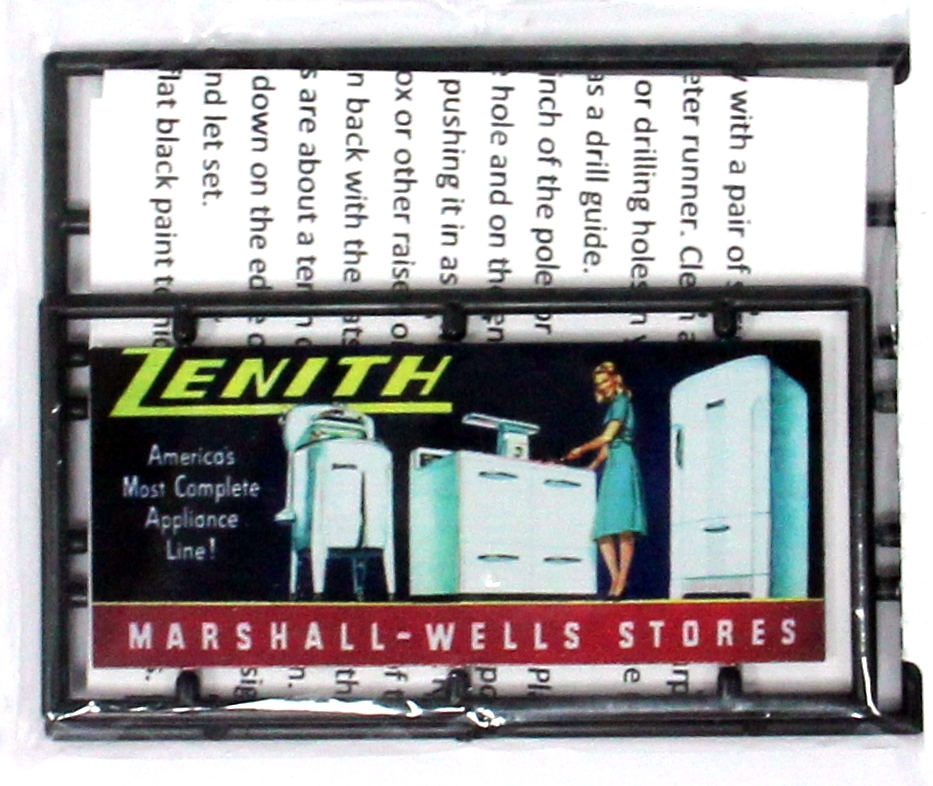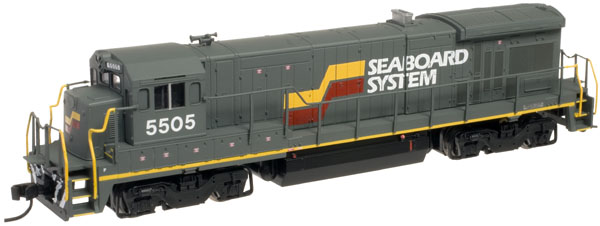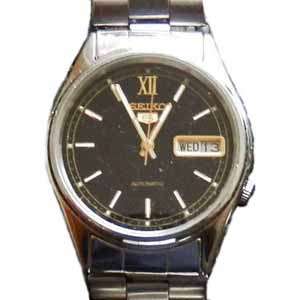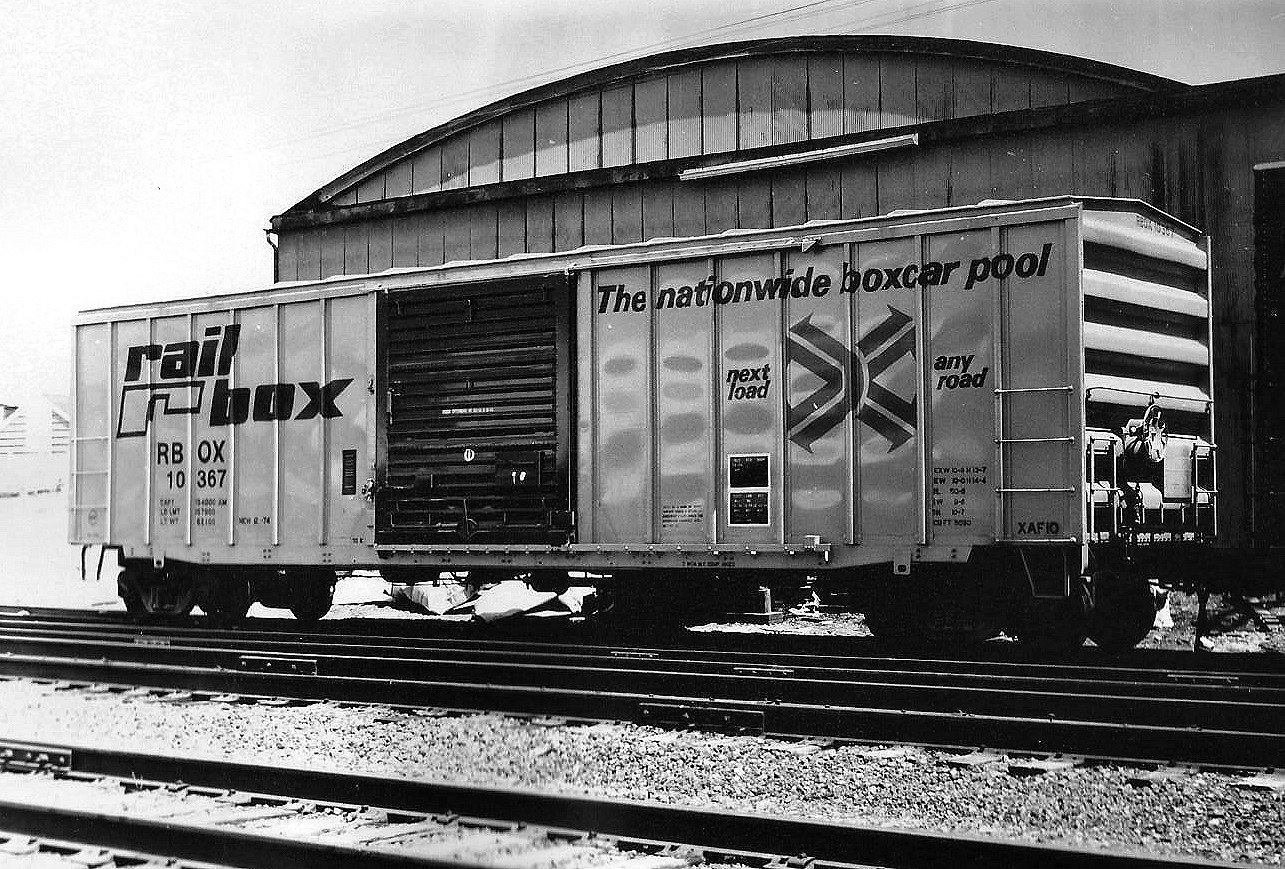Model Information: This model was introduced in 2016. It is part of Atlas' "Master" line of N Scale products. These Atlas N scale Plate B Boxcars feature early and late body styles with single sliding doors, body mounted couplers, and X-Panel roofs.
Prototype History: In the 1970's with the growth of the Per Diem business model, FMC produced a series of 50 foot box cars in different configurations. The single-sliding-door configuration is one of the best known and used widely by many different railroads. These cars were produced using the Gunderson metal works which FMC had acquired in 1965. In late 1975, FMC began producing a 5,077-cubic-foot Plate B box car for IPD and Railbox service. FMC's 5077s have seven panels to either side of the 10-foot door, an X-panel roof, and non-terminating ends that are slightly different from those used on FMC's earlier cars. Note how the sidesill is notched all the way back to the bolsters, a key feature of FMC's mature design.
The main difference between the 5077 cu. ft cars built by FMC vs the 5277-5347 cu. ft cars built by the same manufacturers is the overall height of the car, the smaller 5077 cars were Plate B while the larger 5277-5347 cars were Plate C. Over 4,300 cars were produced from 1975-1979 by FMC's Portland, Oregon plant. The cars were delivered in numerous colorful shortline paint schemes, as well as the nationwide car pool fleet of Railbox. Many secondhand cars were later seen in Class 1 railroads and large leasing company fleets under additional shortline reporting marks.
The main difference between the 5077 cu. ft cars built by FMC vs the 5277-5347 cu. ft cars built by the same manufacturers is the overall height of the car, the smaller 5077 cars were Plate B while the larger 5277-5347 cars were Plate C. Over 4,300 cars were produced from 1975-1979 by FMC's Portland, Oregon plant. The cars were delivered in numerous colorful shortline paint schemes, as well as the nationwide car pool fleet of Railbox. Many secondhand cars were later seen in Class 1 railroads and large leasing company fleets under additional shortline reporting marks.
Road Name History:
The E&LS was built in 1898 to link the harbor of Escanaba to a connection with the Milwaukee Road in Channing in Michigan’s Upper Peninsula. The mileage during this first period was about 68.
The E&LS dieselized with an all Baldwin fleet and the road would remain all-Baldwin until the expansion in 1980. That year, Milwaukee Road was in the process of spinning off lines left and right so the Escanaba & Lake Superior leased routes from Channing northwest to Ontonogon near the Minnesota border, and from Channing south to Green Bay, Wisconsin giving the system map a lopsided T shape. At this point the mileage was up to 325 miles. Four years later, E&LS bought those lines from Milwaukee Road (which was being sold to Soo at the time.) Secondhand EMD’s were brought in to help the aging fleet of Baldwins. By 1991, half the fleet was EMD and the other half Baldwin. In the last few years, E&LS obtained trackage rights on Canadian National to shorten the route for traffic between Escanaba and Green Bay.
The Baldwin fleet included the two former Delaware & Hudson RF16A shark nose units that had been railfan favorites in the Northeast in the 70s. Both sharks are still on the property but are stored out of sight. In the last couple of decades, E&LS had trouble with people stealing parts such as bells and builder plates from their increasingly rare Baldwins. This has made E&LS hostile to railfans so if you find yourself in this neck of the woods, stay well clear of E&LS property.
The E&LS dieselized with an all Baldwin fleet and the road would remain all-Baldwin until the expansion in 1980. That year, Milwaukee Road was in the process of spinning off lines left and right so the Escanaba & Lake Superior leased routes from Channing northwest to Ontonogon near the Minnesota border, and from Channing south to Green Bay, Wisconsin giving the system map a lopsided T shape. At this point the mileage was up to 325 miles. Four years later, E&LS bought those lines from Milwaukee Road (which was being sold to Soo at the time.) Secondhand EMD’s were brought in to help the aging fleet of Baldwins. By 1991, half the fleet was EMD and the other half Baldwin. In the last few years, E&LS obtained trackage rights on Canadian National to shorten the route for traffic between Escanaba and Green Bay.
The Baldwin fleet included the two former Delaware & Hudson RF16A shark nose units that had been railfan favorites in the Northeast in the 70s. Both sharks are still on the property but are stored out of sight. In the last couple of decades, E&LS had trouble with people stealing parts such as bells and builder plates from their increasingly rare Baldwins. This has made E&LS hostile to railfans so if you find yourself in this neck of the woods, stay well clear of E&LS property.
Brand/Importer Information: In 1924 Stephan Schaffan, Sr. founded the Atlas Tool Company in Newark, New Jersey. In 1933 his son, Stephan Schaffan, Jr., came to work for his father at the age of sixteen. Steve Jr. built model airplanes as a hobby and frequented a local hobby shop. Being an enterprising young man, he would often ask the owner if there was anything he could do to earn some extra spending money. Tired of listening to his requests, the hobby-store owner threw some model railroad track parts his way and said, "Here, see if you can improve on this".
In those days, railroad modelers had to assemble and build everything from scratch. Steve Jr. created a "switch kit" which sold so well, that the entire family worked on them in the basement at night, while doing business as usual in the machine shop during the day.
Subsequently, Steve Jr. engineered the stapling of rail to fiber track, along with inventing the first practical rail joiner and pre-assembled turnouts and flexible track. All of these products, and more, helped to popularize model railroading and assisted in the creation of a mass-market hobby. The budding entrepreneur quickly outgrew the limitations of a basement and small garage operation. Realizing they could actually make a living selling track and related products, Steve and his father had the first factory built in Hillside, New Jersey at 413 Florence Avenue in 1947. On September 30, 1949, the Atlas Tool Company was officially incorporated as a New Jersey company.
In 1985, Steve was honored posthumously for his inventions by the Model Railroad Industry Association and was inducted into the Model Railroad Industry Hall of Fame in Baltimore, Maryland. In addition, Steve was nominated and entered into the National Model Railroad Association Pioneers of Model Railroading in 1995.
In the early 1990s, the Atlas Tool Company changed its name to Atlas Model Railroad Company, Inc.
In those days, railroad modelers had to assemble and build everything from scratch. Steve Jr. created a "switch kit" which sold so well, that the entire family worked on them in the basement at night, while doing business as usual in the machine shop during the day.
Subsequently, Steve Jr. engineered the stapling of rail to fiber track, along with inventing the first practical rail joiner and pre-assembled turnouts and flexible track. All of these products, and more, helped to popularize model railroading and assisted in the creation of a mass-market hobby. The budding entrepreneur quickly outgrew the limitations of a basement and small garage operation. Realizing they could actually make a living selling track and related products, Steve and his father had the first factory built in Hillside, New Jersey at 413 Florence Avenue in 1947. On September 30, 1949, the Atlas Tool Company was officially incorporated as a New Jersey company.
In 1985, Steve was honored posthumously for his inventions by the Model Railroad Industry Association and was inducted into the Model Railroad Industry Hall of Fame in Baltimore, Maryland. In addition, Steve was nominated and entered into the National Model Railroad Association Pioneers of Model Railroading in 1995.
In the early 1990s, the Atlas Tool Company changed its name to Atlas Model Railroad Company, Inc.
Item created by: nscalemodeler160 on 2016-04-22 02:00:55. Last edited by CNW400 on 2020-06-02 16:49:55
If you see errors or missing data in this entry, please feel free to log in and edit it. Anyone with a Gmail account can log in instantly.
If you see errors or missing data in this entry, please feel free to log in and edit it. Anyone with a Gmail account can log in instantly.


